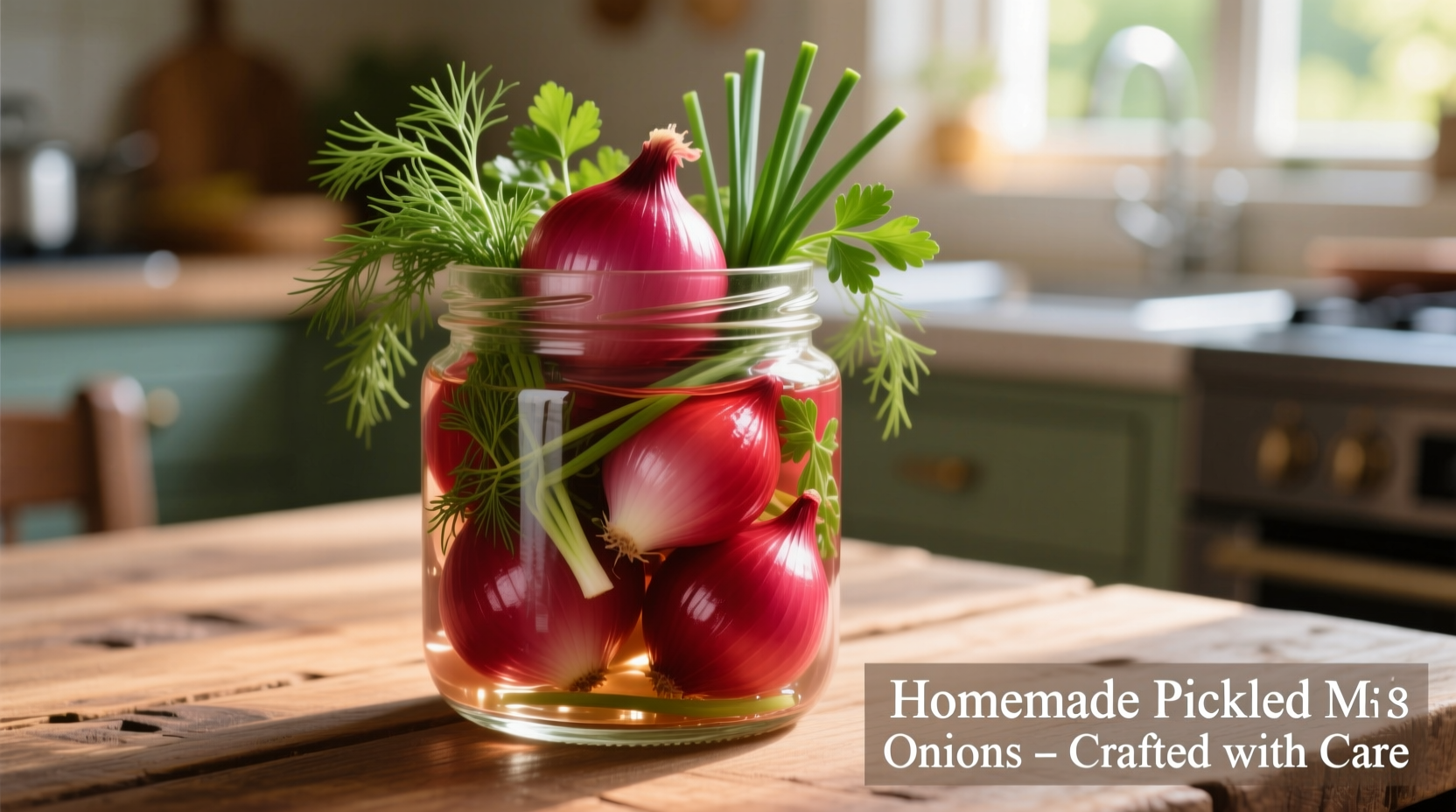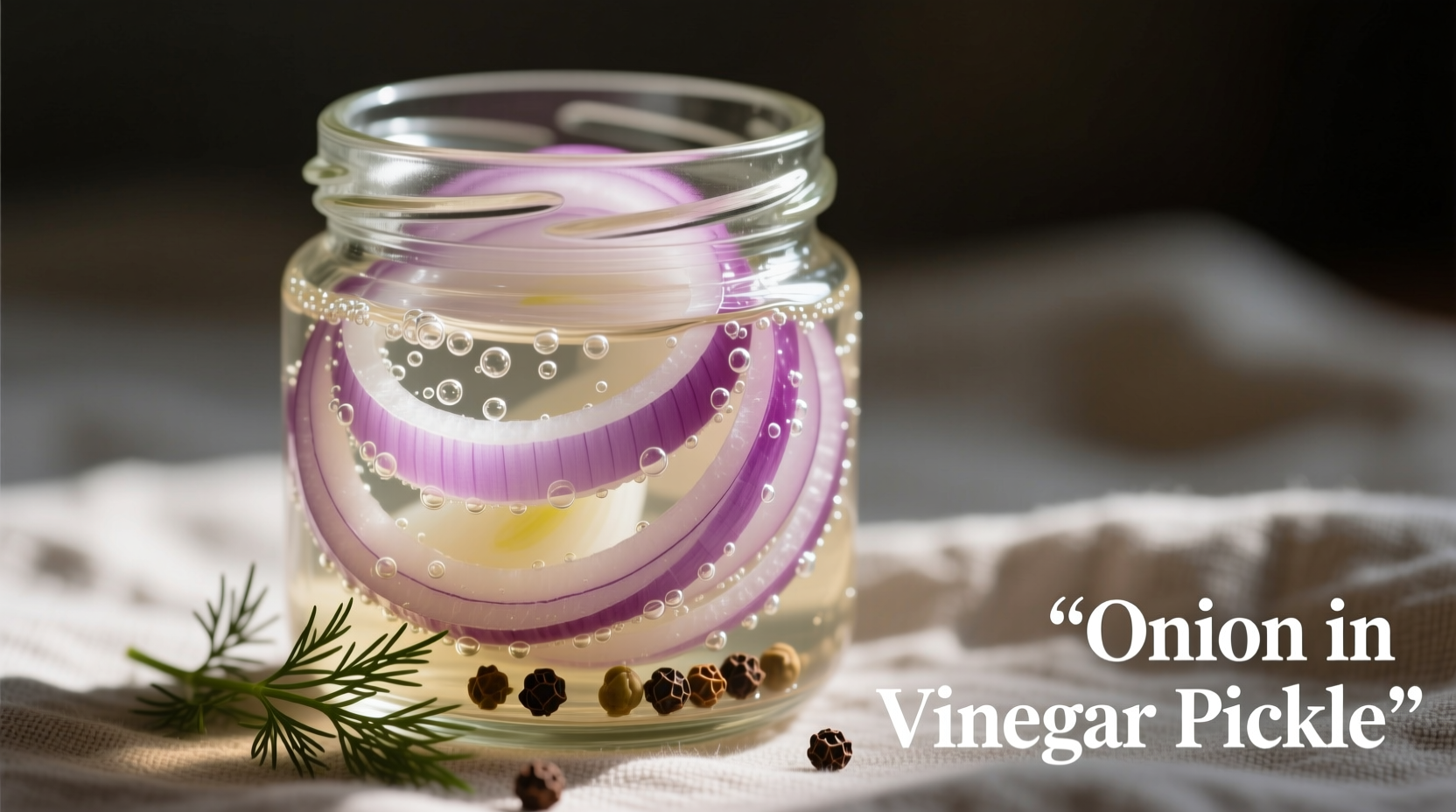The Science Behind Quick Vinegar Pickling
Unlike traditional canning, vinegar pickling relies on acidification rather than heat processing. When onions meet vinegar's acetic acid (typically 5% concentration), it rapidly lowers pH to 4.6 or below—the critical threshold where harmful bacteria like Clostridium botulinum cannot survive. This immediate acid environment preserves texture while transforming sharp raw onions into mellow, complex-flavored gems.
Food safety experts at the National Center for Home Food Preservation confirm that quick-pickled vegetables maintain safety when properly refrigerated. The vinegar's acidity penetrates onion cells within 30 minutes, though optimal flavor develops after 24 hours. This method preserves crunch better than boiling-based canning, making it ideal for fresh applications.
Vinegar Selection Guide: Finding Your Perfect Acid
| Vinegar Type | Acidity Level | Flavor Profile | Best For |
|---|---|---|---|
| Distilled White | 5-7% | Clean, sharp | Classic pickling, bright color retention |
| Apple Cider | 5-6% | Fruity, mellow | Mexican cuisine, pork dishes |
| Champagne | 5-6% | Delicate, subtle | Fish tacos, gourmet applications |
| Red Wine | 6-7% | Robust, complex | Mediterranean dishes, vibrant color |
Always verify acidity levels—USDA guidelines require minimum 5% acetic acid for safe quick pickling. Avoid homemade vinegars or diluted solutions, which may not reach necessary pH levels. For consistent results, choose commercial vinegars labeled with specific acidity percentages from USDA-verified producers.
Step-by-Step Quick Pickling Process
Yield: 2 cups | Prep: 15 minutes | Ready in: 30 minutes
- Prepare onions: Thinly slice 2 medium red onions (¼-inch thickness) using mandoline for uniform pieces
- Create brine: Combine 1 cup vinegar, ½ cup water, 2 tbsp sugar, 1 tbsp salt, and desired spices in glass measuring cup
- Heat gently: Microwave brine 60-90 seconds until steaming (do not boil) to dissolve sugar/salt
- Combine: Pour hot brine over onions in airtight container, ensuring complete submersion
- Cool: Let sit at room temperature 30 minutes before refrigerating
- Store: Keep refrigerated in sealed container for up to 4 weeks
Professional chefs like Antonio Rodriguez emphasize the critical cooling phase—immediate refrigeration causes rapid temperature change that compromises texture. "Let the onions temper at room temperature for half an hour," he advises, "this gradual cooling preserves that perfect crisp-tender bite."

Flavor Variations Across Global Cuisines
Culinary traditions worldwide have adapted vinegar-pickled onions to local palates. In Mexican cooking, cebollas en vinagre often include oregano and jalapeños, while Japanese su konbu versions incorporate kombu dashi. Recent survey data from the International Food Information Council shows 78% of home cooks now experiment with global variations beyond basic recipes.
Try these chef-tested combinations:
- Mexican street style: Add 1 sliced jalapeño, 1 tsp dried oregano, 2 bay leaves
- Middle Eastern twist: Include 1 tsp sumac, ½ tsp cumin, fresh mint sprigs
- Southern sweet heat: Mix in 2 tbsp honey, 1 tsp crushed red pepper
Storage Guidelines and Safety Considerations
Refrigeration is non-negotiable for quick-pickled onions—they're not shelf-stable like canned preserves. The FDA's Food Code guidelines specify that acidified foods must remain below 40°F (4°C) to prevent bacterial growth. Always use clean utensils when serving to avoid contamination.
Discard if you notice:
- Cloudiness or sediment (beyond normal spice settling)
- Foaming or bubbling in container
- Off smells or slimy texture
For extended storage beyond 4 weeks, freeze portions in ice cube trays then transfer to freezer bags—though texture will soften slightly upon thawing.
Troubleshooting Common Issues
Problem: Onions remain too sharp
Solution: Soak sliced onions in ice water for 10 minutes before pickling to remove excess sulfur compounds
Problem: Mushy texture
Solution: You likely used overripe onions or boiled the brine too vigorously. Always use firm, fresh onions and heat brine just until ingredients dissolve.
Problem: Weak flavor penetration
Solution: Increase vinegar-to-water ratio to 3:1 and add ¼ tsp citric acid to accelerate acidification without altering taste.
Perfect Pairings: Where to Use Your Pickled Onions
Elevate everyday dishes with these professional chef recommendations:
- Tacos and burritos: Adds bright contrast to rich meats (especially carnitas)
- Grain bowls: Cuts through earthy grains like farro and quinoa
- Cheese boards: Complements aged cheeses like Manchego and sharp cheddar
- Cocktail garnishes: Elevates martinis and bloody marys with visual pop
"The magic happens when the vinegar's acidity cuts through fatty foods," explains Antonio Rodriguez. "That's why they're perfect on burgers—the tang balances the richness in a way raw onions never could."











 浙公网安备
33010002000092号
浙公网安备
33010002000092号 浙B2-20120091-4
浙B2-20120091-4